Ancestry.com indexes aren’t always right, making it more difficult to search successfully for your ancestors in old records. In many cases, you can correct those errors and help others find it in the future. Here’s how to do it.
When the announcement was made that microfilm lending from the Family History Library was ending, we received many emails from disappointed fans. Vera, in Ontario, Canada, said she had appreciated the access to microfilmed records because, she says:
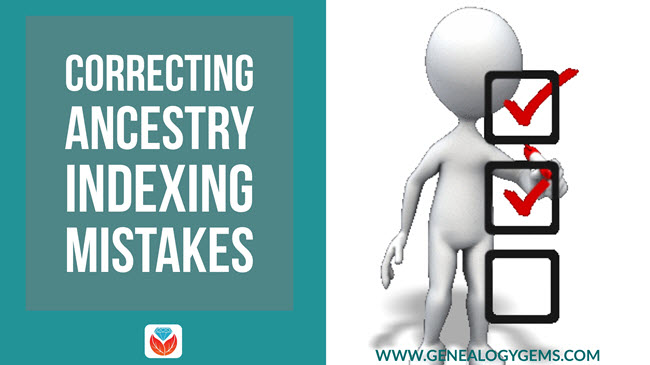
“I find the indexes and transcriptions for information digitized is often incorrect. This is especially true on Ancestry.com.”
Vera is right that you shouldn’t fully rely on indexes to tell you whether your ancestors appear in records! Indexers make mistakes when they transcribe names. Or, perhaps the indexer is transcribing it as it appears, but the spelling is different, or it’s just really tough to decipher. Sometimes it takes an informed descendant’s eye—like yours!—to read an entry correctly or to contribute a spelling that’s more common.
If you don’t find ancestors in indexed records where you think they should be, browse the digitized records page-by-page for that time period and locale. (Click here to read a post on how to browse records at FamilySearch.org: a similar technique applies at Ancestry.com and other sites.)
You can also use advanced search techniques, like searching without the first or last name (or both), searching instead with other known characteristics such as the gender, age, place, and another relative’s name.
User-submitted corrections in Ancestry.com Indexes
When you DO find your ancestor in an Ancestry.com record that was incorrectly indexed, you might be able to fix it! The site allows users to submit changes to any indexes they have created themselves. You may even have seen (and benefited from) user-submitted corrections in your search results already. They look like this: 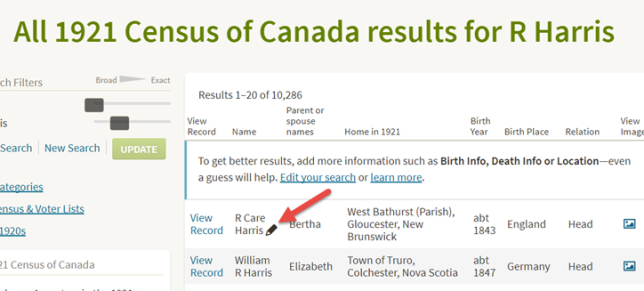
That listing you see means the record was originally indexed as R Care Harris, but someone has submitted a correction.
If you roll over the pencil icon, you’ll see a note that says, “Other possible names: Robert Carr Harris.” Click View Record to the left, and you’ll see the transcribed information: 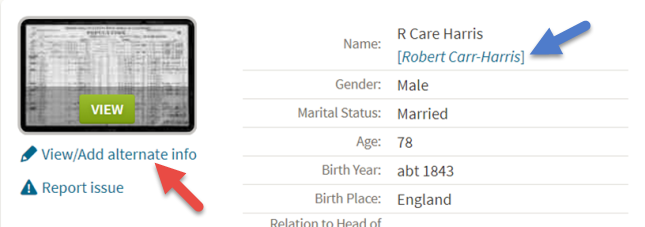
If you click where the blue arrow shows, on [Robert Carr-Harris], you’ll see that an Ancestry user submitted this name correction:
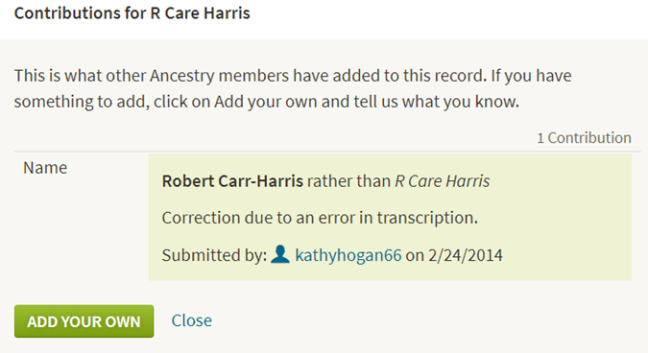
If you have a correction of your own to make to an Ancestry indexed entry, you may click where the red arrow is pointed above, to where it says View/Add alternate information. You’ll see this screen:
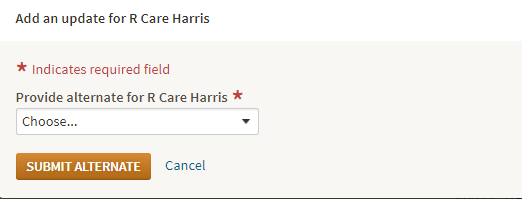
From the drop-down menu, you can choose which fields to correct. In the case of the 1921 Canadian census, you can choose from several different fields to correct, including the name, parents’ birthplaces, occupations, and more. You can even select a field that was left blank if you want to add information here.
As shown below, you must select a reason for making the change. Then you can enter what you think it should say and click Submit Alternate: 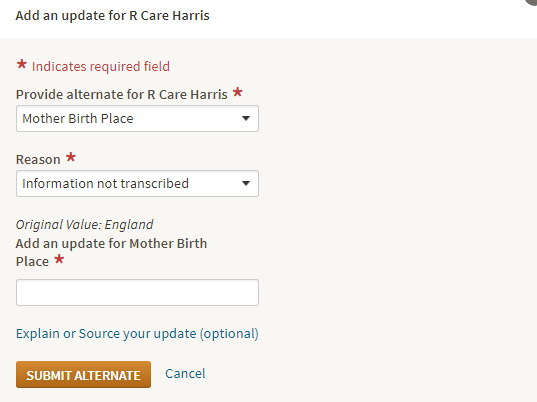
Your corrected version is then added to the searchable index to help others find the same record.
Remember, you can only do this in indexes that Ancestry.com has created itself (not indexes supplied by third parties). But that applies to a lot of major indexes, including several U.S. and Canadian censuses, draft registrations, passenger lists, and more.
Ancestry Pro Tip
An Ancestry user who has corrected an entry for one of your ancestors may be a good person for you to know about. If you’re a subscriber, you can click on the user name to see the user profile and send a message. The user profile may show an AncestryDNA test, recently-added content, any of that person’s public trees, and a personal description.
The user who corrected the entry above defines herself as an advanced genealogist who has been researching since 1985, does research almost every day, and is currently active on Ancestry.com. If Robert Care (or Carr) Harris were my ancestor, I would definitely want to meet her!
Learn How to Fix an Ancestry Online Family Tree:
(Click on player to unmute sound)
Pick the right records website for you!
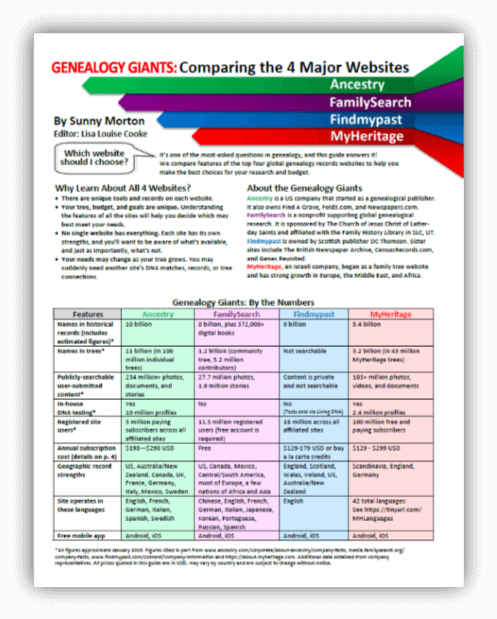
Disclosure: This article contains affiliate links and Genealogy Gems will be compensated if you make a purchase after clicking on these links (at no additional cost to you). Thank you for supporting Genealogy Gems!
This article was originally published on July 25, 2017 and updated on March 27, 2019.

Ancestry uses OCR (optical character recognition) but the transcript isn’t verified by anyone other than us who access the records and correct the mistakes. It’s very frustrating as we pay for access to the records and then we do the hard work for Ancestry
I have been a family researcher for almost 30 years. I know I carry out good research and carefully document and add sources on my family trees. No one else has ever been given permission to contribute to any of my trees.I always believed other researchers could trust and accept my research and results with confidence.
After Ancestry.com introduced LifeStory in the fall of 2015, that changed! I began to find major errors in each of my trees. These were not errors made by me, but the new system. I contacted ancestry at the time about this but received no response. Oddly enough, I have not heard other people I know complaining about this, but there must be others who have experienced the same thing.
I have over 2500 people in the trees I manage and have been slowly going through each person to locate errors and correct them. One of the assumptions LifeStory made had my grandmother with two husbands. It stated that the name of one was unknown. I had two sources for the only marriage of my grandmother, so I wondered if this is how the concept of two husbands arose. It did not happen in every situation where I had two sources for the same event; thus, there appeared to be no consistent formula.
The worst I have come across, however, was in my husband’s tree. LifeStory gave my sister- in-a- law a father! Even on her birth certificate (1934) there is no father’s name given, but ancestry created one for her, linking her to her mother’s second husband. In fact, the man came to Canada over 20 years after my sister-in-law was born and did not meet and marry my mother-in-law for another 10 years after that. As a result, I have had to go through and make changes to the individual pages of my sister-in-law; her three children (who, because of the errors, now had a new grandfather); my mother-in-law; and the man himself.
I have continued to find errors and will eventually go through each of the people and correct them; but it is a time consuming process, and one that is also highly frustrating. I have invested over 11 years on this site and value the access to copies of records; however, I lost a lot of trust in ancestry.com after the issues that I encountered when LifeStory was introduced. I am unsure if I will continue with them, once all the corrections are made.
I’m new to this and very confused. I did a DNA test. It came back with a very close relative, like sibling. (Who is close to my age ,1yr younger) My real cousin was further down on the paper listes as 1st cousin, that is what she is. I did not know the Close relative. I talked my sister into taken the test, her results does not list this extremely close relative. But does list the 1st cousin and i show up as extermly close relative on hers and she on mine.
I contacted this extremely close relative, like sibling, I can’t locate any names that we have in commom on the DNA results or any names she gave me.
Can there be complete errors. Can I ask to delete all my data and try to retake the test or take a different company test. If I delete all family tree, I would still have rceived the same result correct. Its base on DNA from spit, right.
There are a total of 3 real sister and 2 cousins that took this A.com test, none of the, show this person I’m talking about. I don’t think she is my/our relative. What should I do? Its to greek to me. Thanks for any help or pointing me in the right direction. I’m afraid if I context the, they will say, well if its on your report, it must be true.
Hi Dick, Thanks for your comment. My guess is that the OCR-indexing to which you refer is the relatively new practice of using OCR to automatically index enormous, published collections, such as Ancestry.com’s city directories and yearbooks. These auto-indexes make it much faster for us to search them.
OCR is optical character recognition, which is generally applied to printed, not handwritten, materials. Most genealogy records, including the collections mentioned in this post, are handwritten records. The indexes that Ancestry.com and others use online have been created and verified by humans. Intelligent character recognition (ICR) technology that would automate handwritten records indexing is improving, but hasn’t fully been implemented, to my knowledge.
Lifestory has messed up some of my records also. My favorite mistake was for my great-grandmother, born in Rose, Prussia. There is no Rose, Prussia now, as it is now in Poland – exact whereabouts unknown. I was surprised to see a new hint in my cousins’s tree for my great-grandmother as being born in Rose, Texas! She had lifestory turned on, I keep it off. Ancestry tried to fill in a missing hole for us, I guess.
Hi Sue. Thanks for your comment. I would like to look into your frustration a little more before I comment on it. Good luck with your research and congrats for working hard to have an accurate tree.
I have been making corrections since ancestry.com made it possible. Very frustrating to see the mistakes. Sometimes it won’t allow me to make corrections. It states that it is not available at the time. So I have to make note and go back later. It seems that some things I was able to find in the about 10 years ago now have mistakes that make them unsearchable and I have to make corrections. Is Life Story connected to the FamilyTreeMaker trees that are linked to Ancestry.com? I don’t find Life Story particularly useful cause I make my own. I don’t pay much attention to other trees.
What can one do when you find that a whole page has been left out of a census? I found that, when the microfilm was made from the original, one page was scanned twice and the next page was omitted. Everyone in this rural area is missing. Because I live in the missing area and many other descendant do too, we know who should be there. Every site that offers census records has the same error. I have gone through each page for the nearby town and all the surrounding areas in case it was placed on the wrong film, no such luck. Is there a way to get a copy of the original missing census page?
I have barely been on ancestry.com and have found my own mother’s name misspelled a few times. References are made to her obituary. However, I am the only one to my knowledge who ever submitted any obituaries on her anywhere. There have been rumors that the LDS church changes the spellings on names they find in Obituaries so that they can do their posthumous baptisms. To what degree has this impacted the accuracy of this entire website? Because if false records are purposely being included on ancestry.com as a result of this, then it could both explain other’s complaints about the ongoing errors as well as decrease the accountability of your site if this type of thing is taking place.
Hi Tami,
In the past, the spelling of our ancestors’ surnames wasn’t standardized, so you’ll often find various spellings for them. This is especially true for immigrant generations whose surnames may have been spelled a few different ways before each branch of the family “settled” into one spelling.
However, with your mother, that would be a much more recent issue and probably has a different explanation. One possibility is that the misspelled names coming up are actually not her but someone else with a similar name. Another possibility is that her name was mis-read or mis-transcribed from someone who was typing it up to make it searchable on Ancestry.com or FamilySearch.org. A third possibility is that a distant cousin of yours who knew about your mother entered information about her but didn’t get it exactly right. To the best of my knowledge, the LDS practice of ancestral baptism does not involve changing the spellings of people’s names. My experience is that the church encourages people who would like to submit ancestors’ names for baptism to be as accurate as possible.
To Constance: I recommend you read this blog post about missing census pages: https://lisalouisecooke.com/2017/01/21/missing-census/. Also, I’m aware that FamilySearch has reindexed some material that was missed in the original census indexes (I’m specifically thinking of the 1910 census). I encourage you to contact FamilySearch to ask them whether they have updated their indexes for the year/place you are missing.
I’m having problems with some indexes from Germany. I get that it is very difficult to decipher German handwriting (called Sutterlin). But my ancestral village has been completely misindexed. The files that are supposedly from Hainbach are for some other town entirely. The Hainbach files are misindexed and included in the village of Haiger! I don’t have time to correct the record for every record in the index – but I can’t figure out who to contact at Ancestry to get them fixed. Frustrating.
Much of the information is not available anywhere else quite yet – the church records are filmed but not indexed quite yet. The original books are damaged. The civil records are misindexed. Some church records are available as records, but no images. (If you are familiar with German records, you know there is a ton of valuable information on every civic record – parent’s birth villages, mother’s maiden name, witnesses, narration notes, dates…)
I would like to know how to have John keiler Erickson born 1854 Sweden, deleted as being married to Elizabeth Sarah Erwin and both living in Fosterville Victoria Australia. Our John Erickson, my father’s father, according to our family had no middle name. also He was a Ships Carpenter and was employed on the armed Merchant Sailing Ship the Coldstream on its voyages around the world and his last trip was to New York, where after loading cargo for Victoria, sailed from New York to Melbourne. This John keiler Erickson came by ship to Australia as a passenger, not as a crew member. Then there is the photo of John Keiler Erickson, his facial features do not match any of the faces in any of our family photos. How do we go about correcting all this.
I need to change the date of my mother death also the name of my children’s father. I have just found these errors.
Ancestry.com list a town in Lithuania (Wapszach) where my grandfather was born, but there is no such town in Lithuania or Poland or anywhere that I can find.